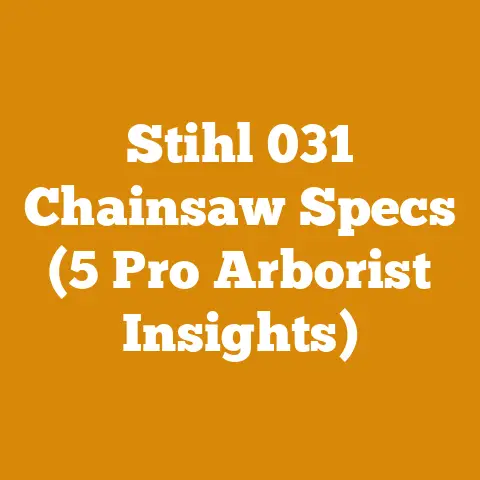Chipper Blade Sharpening Jig (5 Pro Tips for Longer Knife Life)
Alright, let’s dive into the world of chipper blade sharpening and how to squeeze every last bit of life out of those vital knives. I remember the first time I sharpened my own chipper blades – a mix of excitement and a healthy dose of trepidation. It felt like performing surgery on a crucial part of my wood processing operation. Over the years, I’ve learned a few tricks, some through hard-won experience (and a few chipped blades!), that I want to share. This article isn’t just about sharpening; it’s about understanding the costs associated with chipper blade maintenance and how to budget effectively. It’s about maximizing your investment and minimizing downtime. Let’s get started.
Chipper Blade Sharpening Jig: 5 Pro Tips for Longer Knife Life & Smart Budgeting
Understanding the True Cost of Dull Chipper Blades
Before we jump into the tips, let’s talk about why blade sharpness matters so much. It’s not just about getting a cleaner chip. Dull blades impact everything – from fuel consumption to the lifespan of your chipper itself.
- Increased Fuel Consumption: A dull blade forces the chipper to work harder, leading to significantly higher fuel consumption. I’ve seen fuel costs jump by as much as 25% when running with poorly sharpened blades.
- Reduced Chipping Efficiency: You’ll process less wood per hour, impacting your productivity and profitability. A sharp blade slices through wood with ease, while a dull blade tears and struggles.
- Strain on the Chipper: The extra force required to chip wood with dull blades puts undue stress on the chipper’s engine, bearings, and other components. This can lead to costly repairs and premature wear.
- Lower Quality Chips: Dull blades produce uneven, splintered chips, which may be unsuitable for certain applications, like landscaping or mulching. This can reduce the market value of your chips.
- Increased Vibration: Dull blades cause the chipper to vibrate excessively, which can be uncomfortable for the operator and contribute to machine fatigue.
The cost of dull blades isn’t just the price of new blades; it’s the ripple effect it has on your entire operation. I’ve learned that investing time in proper sharpening is one of the best ways to keep my wood processing business running smoothly and profitably.
Pro Tip #1: Choosing the Right Chipper Blade Sharpening Jig: A Cost-Benefit Analysis
There are many chipper blade sharpening jigs on the market, ranging from simple, inexpensive models to sophisticated, high-precision machines. Choosing the right one depends on your budget, the volume of blades you sharpen, and your desired level of precision.
- Basic Jigs (Under $100): These jigs are typically manual and require more skill and patience to use. They are suitable for occasional sharpening and smaller operations. While the initial cost is low, the time investment and potential for errors can be higher. I started with a basic jig and quickly realized that the inconsistency in the sharpening angle was costing me in blade life.
- Mid-Range Jigs ($100 – $500): These jigs offer a good balance of price and performance. They often feature adjustable angles and clamping mechanisms for more consistent sharpening. They are a good choice for small to medium-sized operations that sharpen blades regularly.
- High-End Jigs ($500+): These jigs are typically motorized and offer the highest level of precision and efficiency. They are ideal for large operations that sharpen a high volume of blades. While the initial investment is significant, the long-term cost savings from extended blade life and reduced labor costs can be substantial.
Cost-Benefit Analysis:
To determine the best jig for your needs, consider the following factors:
- Blade Replacement Cost: How much does it cost to replace your chipper blades? This is a crucial factor, as proper sharpening can significantly extend blade life. According to data from leading chipper blade manufacturers, a set of blades can cost anywhere from $200 to $1,000, depending on the size and type of chipper.
- Sharpening Frequency: How often do you need to sharpen your blades? If you only sharpen blades occasionally, a basic jig may suffice. However, if you sharpen blades frequently, a more efficient jig will save you time and effort.
- Labor Costs: How much does it cost to pay someone to sharpen your blades? If you outsource sharpening, consider the cost per blade and the turnaround time. Sharpening in-house can save you money, but it requires an investment in equipment and training. I remember paying $25 per blade for sharpening, which quickly added up. Switching to in-house sharpening with a mid-range jig saved me hundreds of dollars per year.
- Blade Life Extension: How much longer will your blades last with proper sharpening? This is the most challenging factor to quantify, but it’s also the most important. Studies have shown that proper sharpening can extend blade life by as much as 50% or more.
Example:
Let’s say you replace your chipper blades every 6 months at a cost of $500 per set. You sharpen your blades every month, and you pay $25 per blade for outsourcing. That’s $300 per month in sharpening costs, or $3,600 per year.
If you invest in a mid-range sharpening jig for $300 and sharpen your blades in-house, you can save $3,300 per year in sharpening costs. Furthermore, if proper sharpening extends your blade life by 25%, you’ll save an additional $250 per year in blade replacement costs. That’s a total savings of $3,550 per year!
Actionable Tip: Research different chipper blade sharpening jigs and compare their features, prices, and user reviews. Consider your budget, sharpening frequency, and desired level of precision. Calculate the potential cost savings of sharpening in-house versus outsourcing.
Pro Tip #2: Mastering the Art of Angle: The Key to Sharpness and Longevity
The sharpening angle is critical for both sharpness and blade longevity. The correct angle will vary depending on the type of chipper, the type of wood you’re chipping, and the blade material.
- Understanding the Angle: The sharpening angle refers to the angle between the face of the blade and the grinding wheel. A steeper angle will produce a sharper edge, but it will also be more fragile and prone to chipping. A shallower angle will produce a more durable edge, but it will be less sharp.
- Consulting the Manufacturer: The best way to determine the correct sharpening angle is to consult the chipper manufacturer’s specifications. This information is typically found in the owner’s manual or on the manufacturer’s website. I’ve learned the hard way that deviating from the recommended angle can lead to premature blade failure.
- Experimentation: If you can’t find the manufacturer’s specifications, you may need to experiment to find the optimal angle. Start with a moderate angle (e.g., 30 degrees) and adjust it based on your experience. If the blades are chipping easily, try a shallower angle. If the blades are not sharp enough, try a steeper angle.
- Using a Protractor: Use a protractor or angle gauge to ensure that you’re sharpening the blades at the correct angle. This will help you maintain consistency and avoid errors.
- Maintaining the Angle: It’s essential to maintain the sharpening angle throughout the sharpening process. This requires a steady hand and a good sharpening jig.
Data Point: According to a study by the Forest Products Laboratory, the optimal sharpening angle for chipper blades is typically between 25 and 35 degrees, depending on the wood species. Hardwoods generally require a shallower angle than softwoods.
Practical Example:
I primarily chip softwood, so I use a sharpening angle of 30 degrees. However, when I occasionally chip hardwoods, I reduce the angle to 28 degrees to prevent chipping. I’ve found that this slight adjustment makes a significant difference in blade life.
Actionable Tip: Determine the correct sharpening angle for your chipper blades by consulting the manufacturer’s specifications or experimenting with different angles. Use a protractor or angle gauge to ensure consistency.
Pro Tip #3: The Grinding Wheel Grind: Choosing the Right Abrasive
The type of grinding wheel you use is just as important as the sharpening angle. Different grinding wheels are designed for different materials and applications. Using the wrong grinding wheel can damage your blades or produce a poor-quality edge.
- Aluminum Oxide Wheels: These are the most common type of grinding wheel and are suitable for sharpening most types of chipper blades. They are relatively inexpensive and readily available.
- Silicon Carbide Wheels: These wheels are harder and more aggressive than aluminum oxide wheels. They are ideal for sharpening hard materials like carbide-tipped blades.
- Diamond Wheels: These are the most expensive type of grinding wheel, but they also offer the best performance. They are extremely durable and can sharpen even the hardest materials with ease.
Cost Considerations:
- Wheel Price: The price of grinding wheels can vary significantly depending on the material, size, and grit. Aluminum oxide wheels are the most affordable, while diamond wheels are the most expensive.
- Wheel Life: The lifespan of a grinding wheel depends on the material, the type of sharpening you’re doing, and how well you maintain the wheel. Diamond wheels typically last much longer than aluminum oxide or silicon carbide wheels.
- Blade Damage: Using the wrong grinding wheel can damage your blades, leading to premature wear and replacement.
Data Point: A study by a leading grinding wheel manufacturer found that using a diamond wheel can extend blade life by as much as 20% compared to using an aluminum oxide wheel. However, the initial cost of the diamond wheel is significantly higher.
Personal Experience:
I initially used aluminum oxide wheels for sharpening my chipper blades, but I found that they wore down quickly and didn’t produce a very sharp edge. I switched to silicon carbide wheels, which produced a sharper edge, but they were too aggressive and caused some chipping. I eventually settled on diamond wheels, which are more expensive, but they produce the best edge and last much longer.
Actionable Tip: Choose the right grinding wheel for your chipper blades based on the material, the type of sharpening you’re doing, and your budget. Consider the long-term cost savings of using a more durable wheel.
Pro Tip #4: The Cool Touch: Preventing Overheating and Blade Damage
Overheating is one of the biggest enemies of chipper blades. When blades get too hot, they can lose their temper, become brittle, and crack or chip.
- Keep it Cool: Always use a coolant when sharpening chipper blades. Water is the most common coolant, but you can also use specialized cutting fluids. The coolant will help to dissipate heat and prevent the blades from overheating. I use a simple water drip system to keep the blades cool during sharpening.
- Light Passes: Avoid applying too much pressure when sharpening. Use light, even passes and let the grinding wheel do the work. Applying too much pressure will generate excessive heat and can damage the blades.
- Frequent Dips: Dip the blades in coolant frequently to keep them cool. This is especially important when sharpening thicker blades or using a more aggressive grinding wheel.
- Check the Color: Pay attention to the color of the blade during sharpening. If the blade starts to turn blue or purple, it’s getting too hot. Stop sharpening immediately and let the blade cool down.
Cost Impact:
- Blade Replacement: Overheating can significantly reduce blade life, leading to more frequent replacements.
- Downtime: Replacing blades takes time and can disrupt your workflow.
- Repair Costs: In severe cases, overheating can damage the chipper itself, leading to costly repairs.
Data Point: A study by the American Society of Mechanical Engineers found that overheating can reduce the hardness of steel by as much as 50%, making it more susceptible to wear and damage.
Personal Anecdote:
I once overheated a set of chipper blades while sharpening them. I was in a hurry and didn’t use enough coolant. The blades turned blue and became brittle. They chipped easily and had to be replaced after only a few hours of use. I learned my lesson the hard way – always keep the blades cool!
Actionable Tip: Use a coolant, apply light passes, dip the blades frequently, and check the color to prevent overheating.
Pro Tip #5: The Balancing Act: Ensuring Smooth Operation and Preventing Vibration
Balanced chipper blades are essential for smooth operation and preventing vibration. Unbalanced blades can cause excessive wear on the chipper’s bearings, engine, and other components.
- Why Balancing Matters: Unbalanced blades create vibrations that can damage the chipper and make it uncomfortable to operate. They also reduce the efficiency of the chipper and can lead to lower quality chips.
- How to Balance Blades: There are several ways to balance chipper blades. The simplest method is to use a blade balancer, which is a device that allows you to compare the weight of the blades. If the blades are not balanced, you can remove material from the heavier blade until they are equal in weight.
- Professional Balancing: For the most accurate balancing, you can take your blades to a professional sharpening service. They have specialized equipment that can balance blades to within a fraction of an ounce.
- Cost of Balancing: Balancing blades yourself is relatively inexpensive, as you only need to purchase a blade balancer. Professional balancing can cost anywhere from $5 to $10 per blade.
Cost Savings:
- Reduced Wear and Tear: Balanced blades reduce wear and tear on the chipper, extending its lifespan and reducing repair costs.
- Improved Efficiency: Balanced blades improve the efficiency of the chipper, allowing you to process more wood per hour.
- Higher Quality Chips: Balanced blades produce more uniform chips, which can increase their market value.
Data Point: A study by the National Arborist Association found that unbalanced chipper blades can reduce the lifespan of chipper bearings by as much as 25%.
My Experience:
I used to ignore blade balancing, thinking it wasn’t that important. However, I noticed that my chipper was vibrating excessively and the bearings were wearing out quickly. I started balancing my blades and the vibration disappeared. The bearings also lasted much longer.
Actionable Tip: Balance your chipper blades regularly to prevent vibration and extend the lifespan of your chipper. Use a blade balancer or take your blades to a professional sharpening service.
Cost Components:
- Blade Replacement Costs: This is the most obvious cost component. Track how often you replace your blades and the cost per set.
- Sharpening Costs: This includes the cost of sharpening jigs, grinding wheels, coolant, and labor (if you sharpen in-house). If you outsource sharpening, track the cost per blade.
- Downtime Costs: This includes the cost of lost productivity while blades are being sharpened or replaced.
- Repair Costs: This includes the cost of repairing damage caused by dull or unbalanced blades.
- Fuel Costs: Remember that dull blades increase fuel consumption. Track your fuel costs and compare them to your blade sharpness.
Budgeting Strategies:
- Track Your Costs: The first step in budgeting is to track your costs. Keep detailed records of all blade-related expenses.
- Set a Budget: Based on your historical data, set a budget for chipper blade maintenance.
- Optimize Your Sharpening Practices: Implement the pro tips outlined in this article to extend blade life and reduce sharpening frequency.
- Consider a Preventative Maintenance Program: A preventative maintenance program can help you identify and address potential problems before they become costly.
- Factor in Seasonality: Wood processing is often seasonal. Adjust your budget accordingly.
Data Point: According to industry averages, chipper blade maintenance costs can range from 5% to 10% of total operating costs.
Example Budget:
Let’s say your total operating costs are $100,000 per year. Your chipper blade maintenance budget should be between $5,000 and $10,000 per year.
Actionable Tip: Create a detailed budget for chipper blade maintenance based on your historical data and industry averages. Track your costs regularly and adjust your budget as needed.
The Long Game: Investing in Knowledge and Equipment
Chipper blade maintenance is a long-term investment. By investing in knowledge and equipment, you can significantly reduce your costs and improve the efficiency of your wood processing operation.
- Knowledge is Power: Learn as much as you can about chipper blades, sharpening techniques, and budgeting. Attend workshops, read articles, and talk to experienced operators.
- Invest in Quality Equipment: Don’t skimp on equipment. A high-quality sharpening jig, grinding wheel, and blade balancer will pay for themselves over time.
- Practice Makes Perfect: Sharpening chipper blades is a skill that takes practice. Don’t be afraid to experiment and learn from your mistakes.
- Stay Updated: The wood processing industry is constantly evolving. Stay updated on the latest technologies and best practices.
Final Thoughts:






